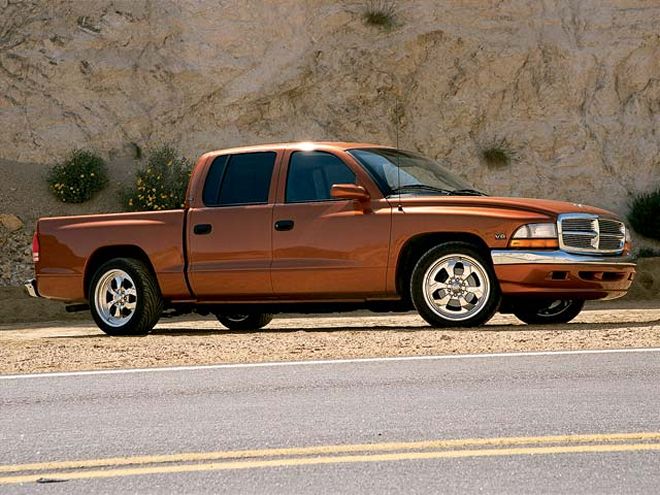
| 2000 Dodge Dakota Quad Cab side View
We are always looking to make our rides lower, faster, and cleaner. Call it an addiction, but you'd have to agree that gearheads can't leave anything alone. Following that logic, we made a few small modifications to our 2000 Dakota Quad Cab. Along with adding some appearance items we lowered the truck a couple of inches and swapped out the wheels and tires.
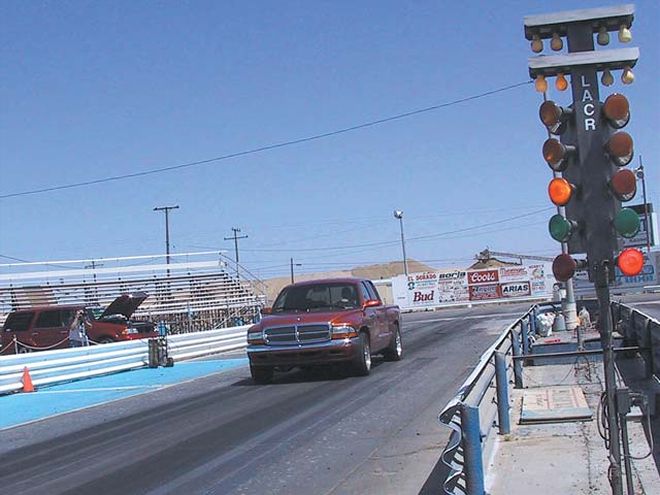
| When the light turned green the Dakota went up in smoke, which killed any good numbers from that run. After a few more runs we got the Dakota to trip the lights at 16.11 at 84.49 mph while fighting a fair amount of tire spin. With simple modifications we cut the e.t. by two tenths and increased the mph by almost a mile. This could mean the difference between looking out the windshield or the rearview mirror to see the competition.
This gave us a sportier look with some added cornering ability, but what about power? Well, we didn't want to leave that out so we got together with Volant to come up with an air intake and Ron Zimmer from Z-Industries to recalibrate the stock computer. These are usually the first power modifications done so we figured we would do some before-and-after tests to find out what kind of improvements are gained. We went out to Los Angeles County Raceway, signed in, and staged the truck at the line. The truck came out of the hole fairly slow and with almost no tire spin, but once the R’s came up, the Dakota's 4.7L started to come alive. After a few trips down the quarter-mile, the Dakota gave us a best time of 16.31 seconds at 83.58 mph. Not too bad for a stock 4,100-pound rig, but it's a number we can improve upon.
The first thing we did to the truck was swap the rims and tires. The smaller overall diameter of our new combo lowered the final drive ratio and gave the motor better leverage to move the Dakota out of the hole a little easier. This raised the cruising rpm and lowered the top speed of the Dakota but not enough to cause any problems other than throwing off our speedo. But check out “Speedometer Stress” (Aug. '01), where we explain how to cure the bogus reading.
Next was the air intake. We contacted the professionals at Volant to see what they could do to help our little Dakota breathe easier. They set us up with one of their air intake systems, which provides a smoother and cleaner path for the air to travel. One thing we overlooked was the amount of noise produced. The factory system has chambers much like a muffler to cancel out the noise produced by the air rushing into the intake. Since these chambers are only there for that purpose and make the system fairly bulky, Volant decided to focus on performance instead of peace and quiet. Once we had the new Volant system in place we were off to Z-Industries to have the computer recalibrated.
On the way there the Dakota sounded like a '70s cop car, with the secondaries wide open. After stopping for gas (because we burned up most of it farting around) we arrived at Z-Industries. Zimmer plugged into the Dakota, and after pounding a few keys, he adjusted the fuel curve, added some more timing, and raised the rev limiter a few hundred. Zimmer was also able to make the computer shut off the A/C at wide-open throttle for improved acceleration. Now it was back to the track for the moment of truth. The results accompany the photos.
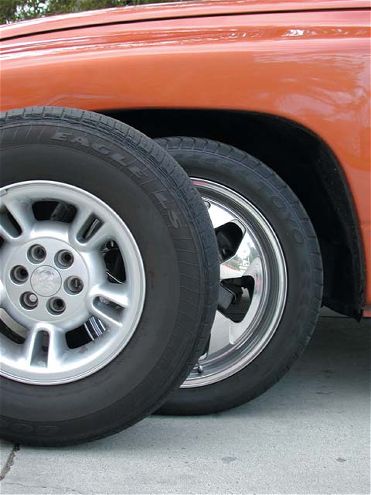
| 2000 Dodge Dakota Quad Cab wheels
The smaller overall diameter of the Center Line and Toyo combination acts like a lower gear to aid in moving 4,100 pounds of truck. In addition, the Toyo's Proxes T1-S offers excellent wet and dry grip, exceptional handling, and resistance to aquaplaning, thanks to a unidirectional tread design. Another great feature on the T1-S is the rim protector ridge, which extends beyond the width of the wheel rim and acts as a bumper to protect the wheel from scratches and other damage. This is a nice feature because we don’t want to scratch our new 18-inch Center Line Horizons. The wheels are two-piece and constructed with a rotor-forged center for superior strength, while still remaining light.
 | 2000 Dodge Dakota Quad Cab side View
We are always looking to make our rides lower, faster, and cleaner. Call it an addiction, but you'd have to agree that gearheads can't leave anything alone. Following that logic, we made a few small modifications to our 2000 Dakota Quad Cab. Along with adding some appearance items we lowered the truck a couple of inches and swapped out the wheels and tires.
| 2000 Dodge Dakota Quad Cab side View
We are always looking to make our rides lower, faster, and cleaner. Call it an addiction, but you'd have to agree that gearheads can't leave anything alone. Following that logic, we made a few small modifications to our 2000 Dakota Quad Cab. Along with adding some appearance items we lowered the truck a couple of inches and swapped out the wheels and tires. | When the light turned green the Dakota went up in smoke, which killed any good numbers from that run. After a few more runs we got the Dakota to trip the lights at 16.11 at 84.49 mph while fighting a fair amount of tire spin. With simple modifications we cut the e.t. by two tenths and increased the mph by almost a mile. This could mean the difference between looking out the windshield or the rearview mirror to see the competition.
This gave us a sportier look with some added cornering ability, but what about power? Well, we didn't want to leave that out so we got together with Volant to come up with an air intake and Ron Zimmer from Z-Industries to recalibrate the stock computer. These are usually the first power modifications done so we figured we would do some before-and-after tests to find out what kind of improvements are gained. We went out to Los Angeles County Raceway, signed in, and staged the truck at the line. The truck came out of the hole fairly slow and with almost no tire spin, but once the R’s came up, the Dakota's 4.7L started to come alive. After a few trips down the quarter-mile, the Dakota gave us a best time of 16.31 seconds at 83.58 mph. Not too bad for a stock 4,100-pound rig, but it's a number we can improve upon.
The first thing we did to the truck was swap the rims and tires. The smaller overall diameter of our new combo lowered the final drive ratio and gave the motor better leverage to move the Dakota out of the hole a little easier. This raised the cruising rpm and lowered the top speed of the Dakota but not enough to cause any problems other than throwing off our speedo. But check out “Speedometer Stress” (Aug. '01), where we explain how to cure the bogus reading.
| When the light turned green the Dakota went up in smoke, which killed any good numbers from that run. After a few more runs we got the Dakota to trip the lights at 16.11 at 84.49 mph while fighting a fair amount of tire spin. With simple modifications we cut the e.t. by two tenths and increased the mph by almost a mile. This could mean the difference between looking out the windshield or the rearview mirror to see the competition.
This gave us a sportier look with some added cornering ability, but what about power? Well, we didn't want to leave that out so we got together with Volant to come up with an air intake and Ron Zimmer from Z-Industries to recalibrate the stock computer. These are usually the first power modifications done so we figured we would do some before-and-after tests to find out what kind of improvements are gained. We went out to Los Angeles County Raceway, signed in, and staged the truck at the line. The truck came out of the hole fairly slow and with almost no tire spin, but once the R’s came up, the Dakota's 4.7L started to come alive. After a few trips down the quarter-mile, the Dakota gave us a best time of 16.31 seconds at 83.58 mph. Not too bad for a stock 4,100-pound rig, but it's a number we can improve upon.
The first thing we did to the truck was swap the rims and tires. The smaller overall diameter of our new combo lowered the final drive ratio and gave the motor better leverage to move the Dakota out of the hole a little easier. This raised the cruising rpm and lowered the top speed of the Dakota but not enough to cause any problems other than throwing off our speedo. But check out “Speedometer Stress” (Aug. '01), where we explain how to cure the bogus reading.
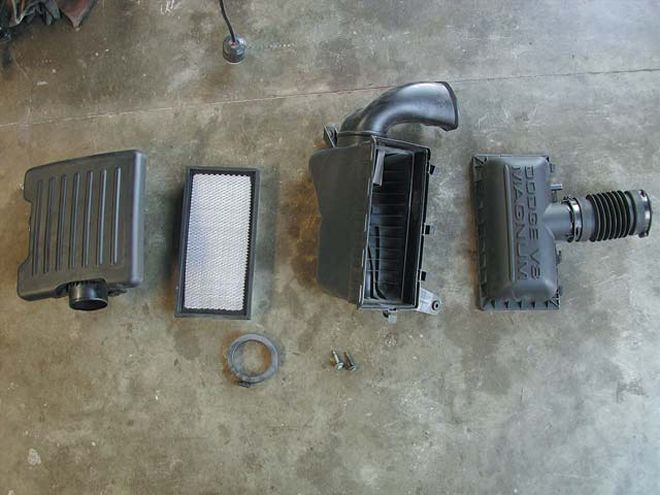
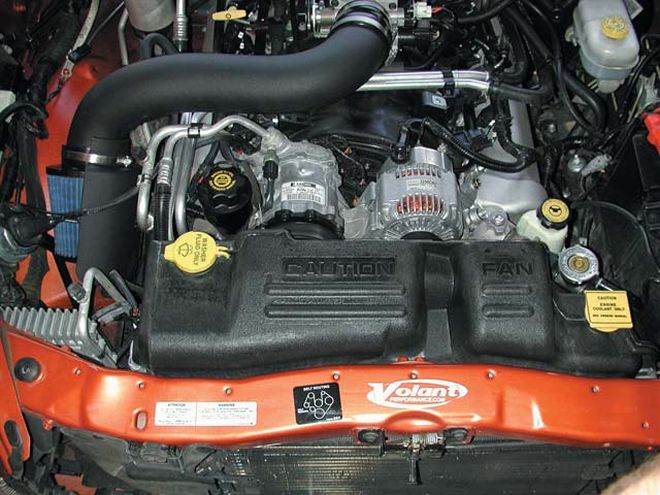
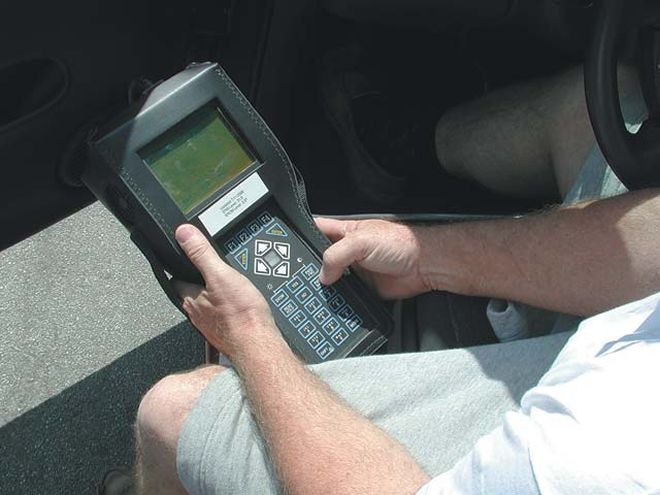
 | 2000 Dodge Dakota Quad Cab wheels
The smaller overall diameter of the Center Line and Toyo combination acts like a lower gear to aid in moving 4,100 pounds of truck. In addition, the Toyo's Proxes T1-S offers excellent wet and dry grip, exceptional handling, and resistance to aquaplaning, thanks to a unidirectional tread design. Another great feature on the T1-S is the rim protector ridge, which extends beyond the width of the wheel rim and acts as a bumper to protect the wheel from scratches and other damage. This is a nice feature because we don’t want to scratch our new 18-inch Center Line Horizons. The wheels are two-piece and constructed with a rotor-forged center for superior strength, while still remaining light.
| 2000 Dodge Dakota Quad Cab wheels
The smaller overall diameter of the Center Line and Toyo combination acts like a lower gear to aid in moving 4,100 pounds of truck. In addition, the Toyo's Proxes T1-S offers excellent wet and dry grip, exceptional handling, and resistance to aquaplaning, thanks to a unidirectional tread design. Another great feature on the T1-S is the rim protector ridge, which extends beyond the width of the wheel rim and acts as a bumper to protect the wheel from scratches and other damage. This is a nice feature because we don’t want to scratch our new 18-inch Center Line Horizons. The wheels are two-piece and constructed with a rotor-forged center for superior strength, while still remaining light.